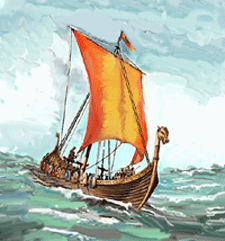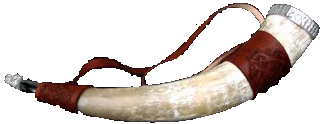| |
|
|
The Viking Longship
or Dragon Ship as the were sometimes called were developed by the
Vikings and Danes of Scandinavian, they were eminently suitable
to the roll they played during the period of Norse  expansion
from the eighth to tenth centuries, when perhaps because of overpopulation
at home they sought new territories to colonize. expansion
from the eighth to tenth centuries, when perhaps because of overpopulation
at home they sought new territories to colonize.
They were categorized by the number of oars
they carried, the smallest 'The Snekkja' would have had about thirty
oars Wood was used in their construction using lap-strake also known
as clinch-built or clinker-built, the keel together with the stem
and stern posts were set up on the keel, on top of the keel the
hog was fixed this was wider than the keel, on the hog the frames
or ribs were assembled, although only a few may have been used initially
to keep the shape of the hull when planking. These structural members
were held together with wooden pegs or trennels 'Tree nails' these
were round pegs which may have been made on a pole lathe, they were
dried and driven into holes drilled in the two pieces of wood to
be joined the ends were cut off flush and a wedge driven into each
end of the peg, when the ship was launched the peg would expand
making it virtually impossible to remove.
The next stage was to plank the hull, the
planks would have been split off a log using wedges, these were then smoothed and shaped,
possibly using an adze each pair of planks being a different shape
as they progressed up the hull. The first plank known as the garboard
was attached to the bottom of the hog which overlapped the keel,
the builders then continued plank after plank overlapping each successive
one until the hull was complete. In boats built up to the tenth
century and a little later the planks were lashed to the frames
after that date pegs (described above) were used, later still iron
nails were used. This type of construction produced a hull that
was light, strong and flexible.
split off a log using wedges, these were then smoothed and shaped,
possibly using an adze each pair of planks being a different shape
as they progressed up the hull. The first plank known as the garboard
was attached to the bottom of the hog which overlapped the keel,
the builders then continued plank after plank overlapping each successive
one until the hull was complete. In boats built up to the tenth
century and a little later the planks were lashed to the frames
after that date pegs (described above) were used, later still iron
nails were used. This type of construction produced a hull that
was light, strong and flexible.
|
The ship was fitted with a mast set a little foreword
of amidships, this was stayed with ropes fore and aft and carried a yard
(Horizontal spar) which could be raised or lowered by ropes, to the yard
was attached a square sail, this rig would not have enabled the ship to sail into the wind as a modern yacht is capable of doing, rather they
probably could sail at ninety degrees to the wind probably making considerable
leeway. They were steered by a rudder or steer board hung on the right
hand side of the ship near the stern, the projecting rudder on the right
of the ship forced it to dock with its left side to a jetty, giving us
our terms for the sides of a ship, port and starboard which is a corruption
of steerboard.
sail into the wind as a modern yacht is capable of doing, rather they
probably could sail at ninety degrees to the wind probably making considerable
leeway. They were steered by a rudder or steer board hung on the right
hand side of the ship near the stern, the projecting rudder on the right
of the ship forced it to dock with its left side to a jetty, giving us
our terms for the sides of a ship, port and starboard which is a corruption
of steerboard.
The narrow hulls of the Viking ships gave them
speed, their relatively shallow draught made them maneuverable when rowed
and enabled them to proceed up rivers to
the heart of Ireland. Their stem and stern posts were often carved
with mythological creatures, when underway the rowers attached their shields
to the side of the ship, presumably giving them protection not only from
the elements but also from attack.
|
|
 expansion
from the eighth to tenth centuries, when perhaps because of overpopulation
at home they sought new territories to colonize.
expansion
from the eighth to tenth centuries, when perhaps because of overpopulation
at home they sought new territories to colonize.  split off a log using wedges, these were then smoothed and shaped,
possibly using an adze each pair of planks being a different shape
as they progressed up the hull. The first plank known as the garboard
was attached to the bottom of the hog which overlapped the keel,
the builders then continued plank after plank overlapping each successive
one until the hull was complete. In boats built up to the tenth
century and a little later the planks were lashed to the frames
after that date pegs (described above) were used, later still iron
nails were used. This type of construction produced a hull that
was light, strong and flexible.
split off a log using wedges, these were then smoothed and shaped,
possibly using an adze each pair of planks being a different shape
as they progressed up the hull. The first plank known as the garboard
was attached to the bottom of the hog which overlapped the keel,
the builders then continued plank after plank overlapping each successive
one until the hull was complete. In boats built up to the tenth
century and a little later the planks were lashed to the frames
after that date pegs (described above) were used, later still iron
nails were used. This type of construction produced a hull that
was light, strong and flexible. sail into the wind as a modern yacht is capable of doing, rather they
probably could sail at ninety degrees to the wind probably making considerable
leeway. They were steered by a rudder or steer board hung on the right
hand side of the ship near the stern, the projecting rudder on the right
of the ship forced it to dock with its left side to a jetty, giving us
our terms for the sides of a ship, port and starboard which is a corruption
of steerboard.
sail into the wind as a modern yacht is capable of doing, rather they
probably could sail at ninety degrees to the wind probably making considerable
leeway. They were steered by a rudder or steer board hung on the right
hand side of the ship near the stern, the projecting rudder on the right
of the ship forced it to dock with its left side to a jetty, giving us
our terms for the sides of a ship, port and starboard which is a corruption
of steerboard.